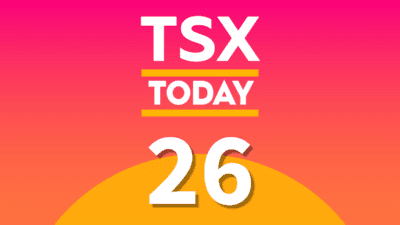Take Stock is the Motley Fool Canada’s free investing newsletter. To have future editions delivered directly to you, simply click here now.
Good day Fellow Fools,
Those of you who have been following along with our Take Stock publication for some time know that every so often we like to bring in a piece that we found particularly insightful from the Fool’s award-winning, U.S.-based analyst Morgan Housel. Today, we have another one of Morgan’s articles that we’d like to share. Though a touch U.S.-centric, it provides a great indication of how the business of personal financial management currently works, and where it might be headed.
Enjoy!
Advertisement
SPECIAL OFFER: The Motley Fool’s Top Stocks … At a Huge Discount!
For a limited time, you can take advantage of a 70% OFF offer to Motley Fool Stock Advisor Canada and see our latest ‘best of the best’ stock recommendations. Get the names, ticker symbols, and full research and analysis on every single one of our favourite stock ideas, all for only $179 for two years of the service, 70% OFF the normal recommended retail price. You’ll get instant access to The Motley Fool’s premium stock-picking service for just 25 cents per day, and save 70%. To get started, click here now!
The Wrong Way to Pay for Financial Advice
By Morgan Housel
“Your margin is my opportunity.” —Jeff Bezos
Imagine you’re checking out at the grocery store. As the clerk scans your bananas, she asks you to step on the scale. “Two-hundred seventy-five pounds,” she reads off. “Your bananas will cost $9.86.”
You are confused. What does your weight have to do with the cost of bananas?
“You weigh more than average,” the clerk explains. “So it costs us more to provide you with bananas.”
But the skinny guy in line behind you just bought the same amount of bananas. He received the same product and the same service as you, but paid half as much.
This infuriates you. How much you weigh shouldn’t alter how much you pay for bananas. It’s the amount of bananas you actually buy, and the service the grocer offers, that should affect prices. Customers would never put up with grocery prices being based off your weight, which is why no one weighs you when go to the grocery store.
But this is how most of the financial industry operates. The price of almost every service you buy takes your weight—or your portfolio’s weight—into consideration.
Most financial advisors charge a fee based on a percentage of your investments, called an asset under management (AUM) fee. If you have $500,000, a 1% fee means you’ll pay $5,000 a year. One million dollars with the same advisor costs $10,000 a year, and so on. This is standard across the industry. Tens of trillions of dollars are managed based on this arrangement.
But why? It’s like charging fat people more for bananas. Clients often receive the same service, the same investments, the same performance, the same brokerage statement, and with the same amount of effort put in by the advisor, but at vastly different prices. Few other industries could get away with this.
AUM fees might make sense for advisors focusing on small-cap or private companies, where managing more money truly becomes a hindrance. But that’s a small exception. It is not 10 times harder to buy 5,000 shares of Microsoft as it is 500 shares, nor is it 10 times as difficult to purchase $5,000,000 in Treasuries as it is $500,000. But advisors will receive 10 times as much in fees.
There are two reasons financial advisors charge AUM fees: It’s how the industry has always operated, and you can make a lot of money doing it. Warren Buffett said a few years ago:
Wall Street markets are so big, there’s so much money, that taking a small percentage [of assets] results in a huge amount of money per capita in terms of the people that work in it. And they’re not inclined to give it up.
But some advisors have given it up. I’m hearing about a growing number of advisors charging a set, flat fee, regardless of the amount of client assets.
“Rather than arbitrarily deriving our compensation from the value of an investor’s portfolio, we have built a retainer fee structure around the services that we provide,” writes James Osborne of Bason Asset Management. This is the how most CPAs operate. His fee structure is simple: “$4,500 per year, per client relationship.”
“Our services do not vary appreciably between clients with larger or smaller portfolios, so our fee structure reflects this,” he writes.
Unless your income depends on AUM fees, it is hard to argue with that logic.
Flat fees will likely lead to lower incomes for advisors—especially large advisors—while clients keep more of their money. Welcome to capitalism! The traditional advisory business has been a honeypot for decades, where advisors could earn more than brain surgeons while lagging their benchmark.
Since stocks tend to grow above the rate of inflation, advisors’ income balloons over time through no effort of their own. If an advisor put his clients in the S&P 500 and went to the beach, his annual income would have grown at six times the rate of inflation over the last 30 years, all without lifting a finger. Competition shouldn’t allow that to occur. “The average AUM-based established advisory firm is running 50%-70% gross margins,” Osborne wrote recently. That’s enormous. And as Jeff Bezos says, “Your margin is my opportunity.” Flat-fee advisors are coming after that opportunity as fast as they can.
I think one of the biggest trends we’ll see over the next decade are financial management fees falling like a rock. They’ve already dropped in recent years, but there’s still enormous fat to cut. Not only will AUM fees be pressured to decline, but the way advisors charge may be upended. The winner is you, the investor.
Wrapping it up
Many thanks as always to Morgan for pointing out another one of the financial world’s crazy idiosyncrasies.
Just to provide some perspective for our home market here in Canada, even though this %-of-AUM based model is very popular in both the U.S. and Canada, the market for financial advice is much broader south of the border, with a wide variety of organizations competing for the same pool of dollars to manage.
Though we have some variety here north of the 49th, our personal financial management industry is dominated by the Canadian banks and several other large players. These entrenched firms make billions from the system that’s currently in place and have no interest whatsoever in having it altered.
This entrenched model is certainly not a model that we Fools follow with our Stock Advisor Canada advisory service. Whether you’re joining us with a portfolio of $1 billion or $1,000, you’re paying the same low rate.
However, we like to think that Fools are a rare breed—we’re keen to have our incentives aligned with those of our members!
It will be very interesting to see if indeed the fee structure in the U.S. begins to change significantly, how closely our industry follows given the differing competitive dynamics that exist.
Have a great week!
Sincerely,
Iain Butler
Chief Investment Adviser
Motley Fool Canada
P.S. Don’t miss our latest issue of Stock Advisor Canada, featuring both our #1 TSX and #1 U.S.-listed stock for new money. Right now, you can sign up to join Stock Advisor Canada and pay a rate 70% OFF the normal recommended retail price. You’ll get instant access to our online scorecard and receive the names of our very latest ‘best of the best’ stock recommendations. To get started, click here now.







